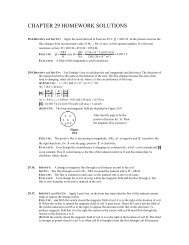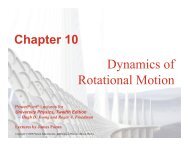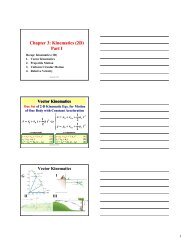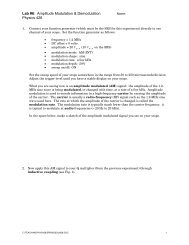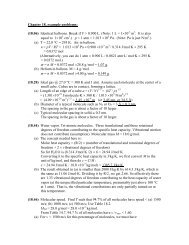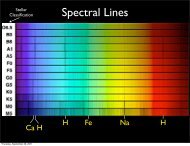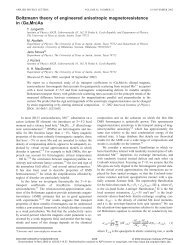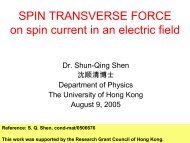P202 Practice Exam 1 Spring 2004 Instructor: Prof. Sinova
P202 Practice Exam 1 Spring 2004 Instructor: Prof. Sinova
P202 Practice Exam 1 Spring 2004 Instructor: Prof. Sinova
- No tags were found...
Create successful ePaper yourself
Turn your PDF publications into a flip-book with our unique Google optimized e-Paper software.
<strong>P202</strong> <strong>Practice</strong> <strong>Exam</strong> 1 <strong>Spring</strong> <strong>2004</strong> <strong>Instructor</strong>: <strong>Prof</strong>. <strong>Sinova</strong>Name: __________________________ Date: _____________1. Each of three objects has a net charge. Objects A and B attract one another. Objects Band C also attract one another, but objects A and C repel one another. Which one of thefollowing table entries is a possible combination of the signs of the net charges on thesethree objects?A B CA) + + −B) − + +C) + − −D) − + −E) − − +2. Consider three identical metal spheres, A, B, and C. Sphere A carries a charge of −2.0µC; sphere B carries a charge of −6.0 µC; and sphere C carries a charge of +5.0 µC.Spheres A and B are touched together and then separated. Spheres B and C are thentouched and separated. Does sphere C end up with an excess or a deficiency of electronsand how many electrons is it?A) deficiency, 6 × 10 13B) excess, 3 × 10 13C) excess, 2 × 10 13D) deficiency, 3 × 10 12E) deficiency, 1 × 10 12Page 1
8. A helium nucleus is located between the plates of a parallel-plate capacitor as shown. Thenucleus has a charge of +2e and a mass of 6.6 × 10 −27 kg. What is the magnitude of theelectric field such that the electric force exactly balances the weight of the helium nucleusso that it remains stationary?A) 4.0 × 10 −7 N/CB) 6.6 × 10 −26 N/CC) 2.0 × 10 −7 N/CD) 5.0 × 10 −3 N/CE) 1.4 × 10 8 N/CThe figure shows a parallel plate capacitor. The surface charge density on each plate is 8.8 × 10 −8C/m 2 . The point P is located 1.0 × 10 −5 m away from the positive plate.9. If a +2.0 × 10 −5 C point charge is placed at P, what is the force exerted on it?A) 0.2 N, toward the negative plateB) 0.2 N, toward the positive plateC) 5 × 10 4 N, toward the positive plateD) 5 × 10 4 N, toward the negative plateE) 5 × 10 4 N, into the plane of the page10. A straight, copper wire has a length of 0.50 m and an excess charge of −1.0 × 10 −5 Cdistributed uniformly along its length. Find the magnitude of the electric field at a pointlocated 7.5 × 10 −3 m from the midpoint of the wire.A) 1.9 × 10 10 N/CB) 1.5 ×10 6 N/CC) 6.1 × 10 13 N/CD) 7.3 × 10 8 N/CE) 4.8 × 10 7 N/CPage 4
11. Two point charges are arranged along the x axis as shown in the figure. At which of thefollowing values of x is the electric potential equal to zero?Note: At infinity, the electric potential is zero.A) +0.05 mB) +0.29 mC) +0.40 mD) +0.54 mE) +0.71 mTwo charges of opposite sign and equal magnitude Q = 2.0 C are held 2.0 m apart as shown in thefigure.12. Determine the magnitude of the electric field at the point P.A) 2.2 × 10 9 V/mB) 5.6 × 10 8 V/mC) 4.4 × 10 8 V/mD) 2.8 × 10 8 V/mE) zero V/m13. Determine the electric potential at the point P.A) 1.1 × 10 9 VB) 2.2 × 10 9 VC) 4.5 × 10 9 VD) 9.0 × 10 9 VE) zero voltsPage 5
14. A parallel plate capacitor with plates of area A and plate separation d is charged so that thepotential difference between its plates is V. If the capacitor is then isolated and its plateseparation is decreased to d/2, what happens to the potential difference between theplates?A) The potential difference is increased by a factor of four.B) The potential difference is twice it original value.C) The potential difference is one half of its original value.D) The potential difference is one fourth of its original value.E) The potential difference is unchanged.15. The effective area of each plate of a parallel plate capacitor is 2.4 m 2 . The capacitor isfilled with neoprene rubber (κ = 6.4). When a 3.0-V potential difference exists across theplates of the capacitor, the capacitor stores 5.0 µC of charge. Determine the plateseparation of the capacitor.A) 7.2 × 10 −5 mB) 3.0 × 10 −4 mC) 1.7 × 10 −4 mD) 5.3 × 10 −4 mE) 8.2 × 10 −5 m16. At which point (or points) is the electric field zero N/C for the two point charges shownon the x axis?A) The electric field is never zero in the vicinity of these charges.B) The electric field is zero somewhere on the x axis to the left of the +4q charge.C) The electric field is zero somewhere on the x axis to the right of the −2q charge.D) The electric field is zero somewhere on the x axis between the two charges, but this pointis nearer to the −2q charge.E) The electric field is zero at two points along the x axis; one such point is to the right of the−2q charge and the other is to the left of the +4q charge.Page 6
Answer Key1. D2. D3. B4. B5. D6. C7. E8. C9. A10. E11. B12. B13. E14. C15. E16. CPage 7



